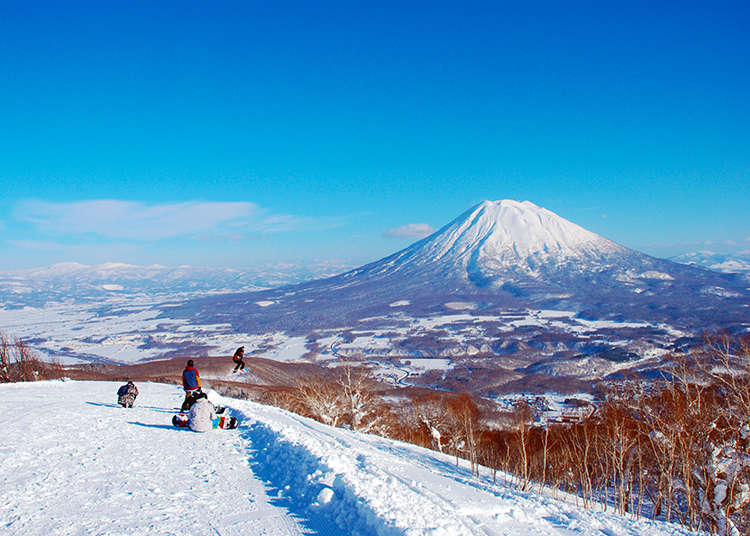
A Japan ski holiday is unlike anywhere else in the world! Winter in Japan may conjure up images of hot sake or a snow-capped Mt. Fuji, but for many people, it is the season to get the skis on and hit the slopes!
Japan may not sound like an obvious skiing holiday destination, but it is easy to forget that it is a mountainous country, and mountains mean good ski slopes in the winter.
You have your pick of around 500 ski resorts across the country, not counting the numerous local slopes that you can discover by pure chance—and ones that offer you the chance for truly unique only-in-Japan experiences like skiing down part of Mt. Fuji itself!
When you include that rental equipment is so cheap, accommodation prices are really reasonable. You can feast on mouth-watering Japanese food every day – going on a Japan ski holiday is a no-brainer!
- Table of Contents
-
- 1. Japan has incredible powder and a huge number of ski resorts
- 2. Enjoy a Japan ski holiday break that won’t break the bank!
- 3. Not Just Skiing - Skiing in Japan is Unique!
- 4. Wherever the crowds are, they aren’t here!
- 5. Enjoy a Trip that Includes Town and Country
- 6. Meet the Friendly People of Japan
- 7. A Skiing Trip which is also a Cultural Trip!
- 8. Ramen, Sake & More – Amazing food and drink!
- 9. Onsen – Japan’s Famous Hot Water Springs which are not to be Missed!
- 10. Gorgeous Instragramable Snow Festivals
1. Japan has incredible powder and a huge number of ski resorts
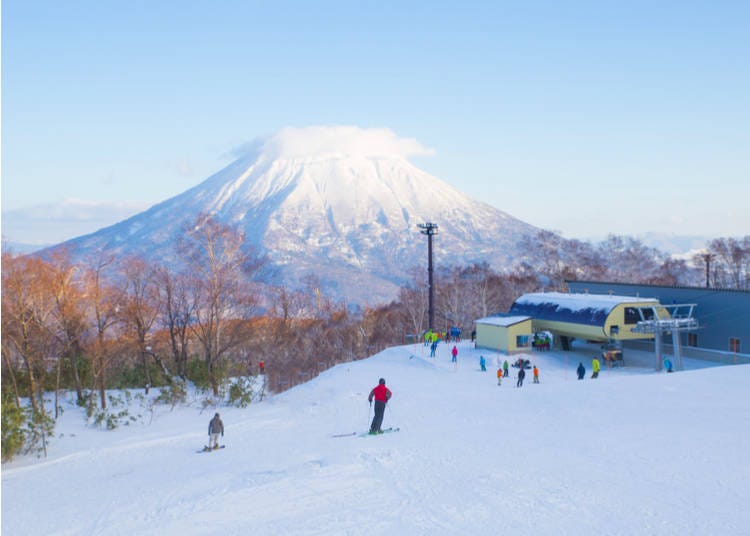
When snowboarders and skiers look at snow, they are interested in the kind of snow that a slope has. For anyone else, snow is just snow, but this isn’t the case if you want to be sliding around in it. The best kind of snow, or powder, has to be dry and deep, and what has slowly come out in recent years is that Japan has some of the driest snow around.
Japanese snow (affectionately known as “Japow” by snow hounds around the world) normally has a moisture content of about 8%, it is light and dry, and fairly heavy snowfall means that it is deep too!
When is the best time to ski in Japan?
Generally, the best time to ski in Japan is from January to February; however, it depends on which ski resort you'll be visiting. The ski season goes from late December to late March, with some areas even having a summer ski season.
2. Enjoy a Japan ski holiday break that won’t break the bank!

One of Japan’s secrets is that going skiing in Japan is effortless, accessible, and affordable.
There are Japan ski resorts accessible directly by the shinkansen bullet train, like Gala Yuzawa near Tokyo (75 minutes - ¥7,090 one way) and resorts accessible by a combination of bullet trains, and a bus like Naeba Ski Resort in Niigata (75-90 minutes, ¥6,470 one way to Echigo Yuzawa, and then either a free shuttle bus (by some hotels) or local bus (¥660) for 40 minutes).
Day tickets for skiing can start from ¥2,500-3000 to ¥6,000 for more expensive resorts (but often including the use of ski lifts).
Gear like skis and snowboards can be rented for normally around ¥3,000-5,000 for a day with usually other fees for ski clothes and boots of around ¥2,000-3,000 and smaller fees for helmets etc.
One of the joys of visiting Japan is the sheer hospitality that people give to visitors. You will find that everywhere people will be delighted to help you if you have questions, give recommendations if you need them, and even show you around in small villages and ski slopes. Japan’s hospitality is legendary and combined with great slopes. It makes for a trip that you will never forget.
Another great aspect of skiing in Japan is the fact that you have the choice between a large number of resorts which are suitable for different budgets, from expensive hotels at flashy resorts to smaller local resorts – and everything that can be imagined in-between. Whatever your budget, you will be able to plan a trip that is perfect for you.
It is quite common to find package deals that include transportation, accommodation, day passes/lift tickets, as well as ski wear and gear rental. It is perfect for a family holiday as the cost per person is quite low, so when your kids say they want to ski Japan, I am afraid that you are out of excuses!
3. Not Just Skiing - Skiing in Japan is Unique!
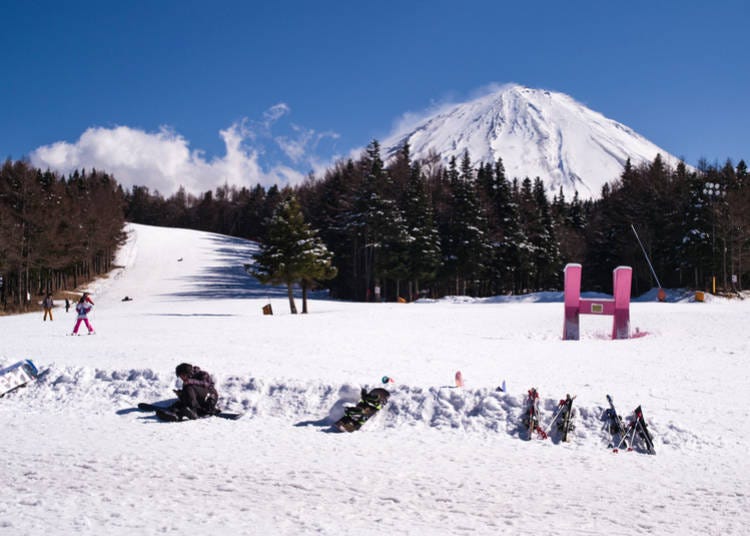
A skiing holiday in somewhere like Europe or America is normally quite typical. You hit the slopes day after day. From day to day, there is some variation but nothing particularly distinctive.
But in Japan, you can get in some truly memorable experiences, say like skiing down Mt. Fuji! Literally skiing down Mt. Fuji is a bit of an exaggeration. Still, there are two ski resorts on Japan’s most famous mountain, Fujiten Snow Resort and Yeti Snow Resort. It is a pretty amazing thing to be able to say that you have skied on this most famous of mountains.
If that isn’t unique enough, how about skiing into the heart of an inactive volcano? Mt. Yotei is located in Hokkaido and is affectionately seen as the Fuji of Hokkaido due to its resemblance to its more famous cousin.
It is an adventurous challenge, one perhaps not suited to the faint-hearted, but you can hike to the top in about five hours, and then you can ski down into the crater – however, once you are out of the crater, you do need to hike back down again!
Another nice aspect about Japanese ski slopes, in general, is that they are often lit up at night and open until quite late – in many cases until 8:30 or 9pm, so you can enjoy some wondrous skiing under the stars – just remember that you do have to leave at some point!
4. Wherever the crowds are, they aren’t here!
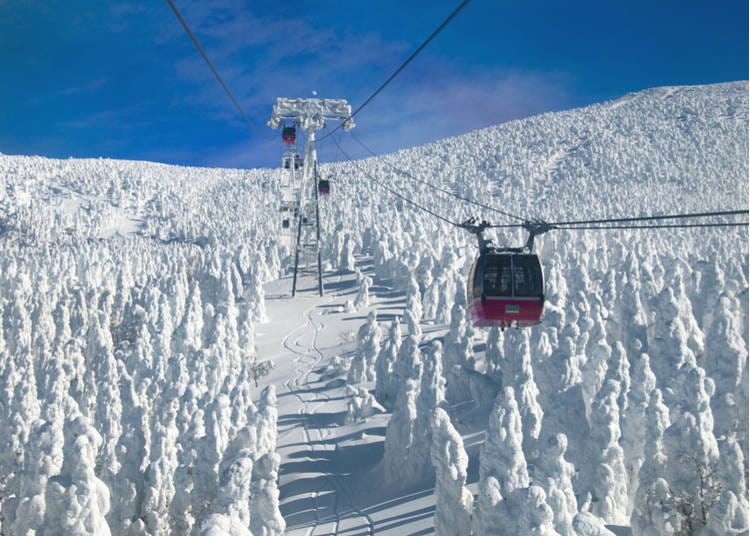
Regulars to ski holidays will be quite inured to the queues to be found everywhere, from taking the ski lift, to waiting for a turn on the slope.
Now, we won’t say there are no queues at all when you ski in Japan, but if you aren’t at a super popular resort at the weekend or during the national holidays, you will find that you can get a lot more slope time in.
As there are some 500 Japan ski resorts, you will find that there just aren’t many people on any particular weekday, so you don’t have to consider the typical queues that you expect to see in most other countries. Quite frankly, fewer people means more time on the slope for you and more virgin snow to ski through!
One of the stressful aspects of any holiday is the crowds, from the airport to the trains to the slopes to the restaurants. Still, again in Japan, unless you happen to be on holiday during a major public holiday like the New Year (avoid!), you aren’t likely to have to deal with the stress of crowds or the frustration of queuing everywhere. You can have a really relaxed trip.
If you take a bit of time to find a local slope rather than a big resort slope, although it will be smaller, you will find there aren’t many people around at all except for a few dedicated locals.
Some websites list resorts in detail (for example, https://snow.gurunavi.com/). You can still check out information counters in train stations or local tourism centers, where staff can tell you their recommendations or make inquiries on your behalf. Also, hotel staff are usually very knowledgeable about the surrounding area.
5. Enjoy a Trip that Includes Town and Country
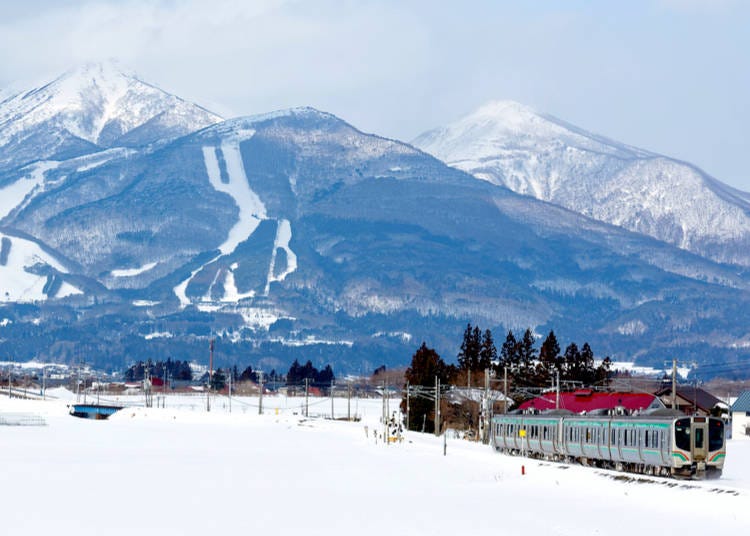
A typical skiing holiday in Europe, for example, involves flying to fairly small airports, heading up to the mountains, and staying there until your flight home forces you back down.
A skiing holiday pretty much means just staying up in the mountains and it isn’t always easy, or convenient, to go to a big city. However, in comparison, Japan is really well connected, by plane, train, bus and car!
Many tourists to Japan don’t actually realize just how much of Japan is covered by frequent, reliable, and inexpensive flights – in particular, in comparison to other countries like the UK, Japan’s transportation system is on another level. This even reaches down to the connectivity of the airports themselves, which are firmly plugged into local transport.
Drill down a bit further and besides the extensive Shinkansen network, which reaches both all the way to the south of the country but also right up to the north, there is an extensive train and bus network.
This basically means it is both easy and convenient to get anywhere from everywhere, you could even stay in a big city like Tokyo or Sapporo and still be able to go skiing every day – though with a bit more travel time then if you stayed in a ski resort or hotel nearby.
If you wanted to, you could take in a range of slopes across the country, ski down Mt. Fuji one day, and then on another head up to Hokkaido to check out the slopes there.
In the area of Iwate prefecture, accessible by shinkansen to Morioka Station (just over two hours from Tokyo Station - ¥14,540 one way), there are kilometers and kilometers of pristine slopes. At the same time, northwest of Tokyo you can find the mountains of Gunma and Niigata prefectures which also have many ski resorts and are also accessible by shinkansen.
For example, Echigo-Yuzawa Station in Niigata is just 90 minutes away by shinkansen (¥6,150 one way). You can spend some of your trip exploring Tokyo and then head up to the mountains for a few days, or vice versa. The world is your oyster, or more accurately, Japan is your oyster!
6. Meet the Friendly People of Japan
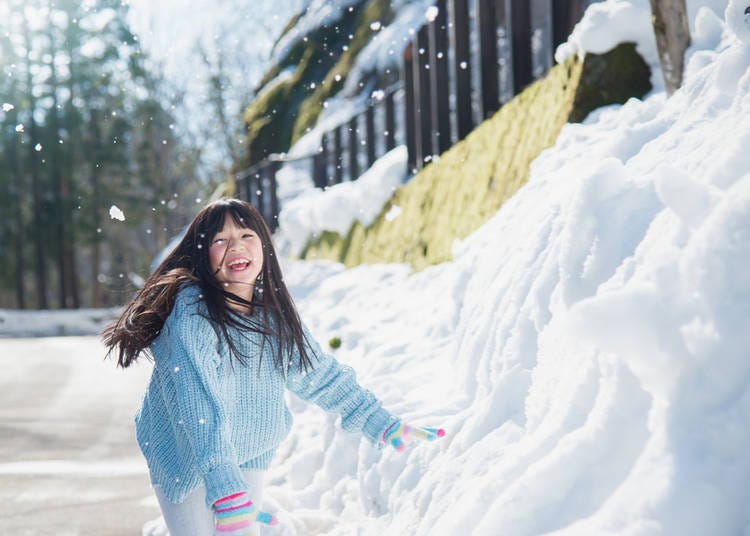
Any typical travel guide will likely describe local people in any country as being welcoming. Still, there is something extra special about Japanese people who are welcoming and really appreciate that tourists fly from so far around the world just to visit their distant country.
You will find that everywhere you go people will not only be welcoming, they will also be really friendly. If you can use the odd Japanese phrase here and there, then their smiles will just get that much more wider.
On top of this, Japanese customer service is almost like an art form. While many other countries preach the concept of “customer first,” the Japanese have fully embraced it. From the smallest hotel to the most luxurious hotel staff members will do everything they can to make your stay easy and to help you with everything they can.
You will have a truly unique experience if you try staying in a local village and use a local slope for skiing rather than a resort, people will help you find your way round, invite you to a drink in local restaurants, regardless of whether you are good or bad on the slopes they will soon be over offering you words of advice. Or, if your skiing is excellent, then they will quickly be over to compliment you.
7. A Skiing Trip which is also a Cultural Trip!
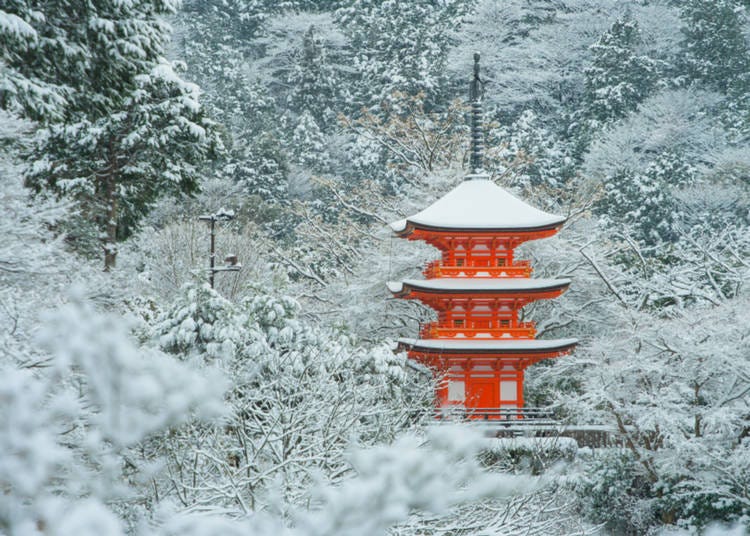
When you go skiing anywhere else, if you take away the skiing, then it can easily be described as just a trip to a hotel or chalet and nothing else – perhaps with some good food and drink. But, go on a skiing trip to Japan, and even if you take away the skiing, you will find that you have been left with many memories of the people, cuisine, and Japanese culture.
In other words, besides being knee-deep in the snow, you will also be knee-deep in culture! When off the slopes, you will meet people who really believe in hospitality, while at every meal you can enjoy food and drink, which is just amazing. If a culture is its food, then Japan is one very cultural country!
Everywhere you go, you will be reminded of how unique Japanese culture is, from temples and shrines high up in the mountains that represent the strong traditions of Japan’s past, to the shining lights of Akihabara in Tokyo, highlighting modern Japan’s fractured yet interconnected sub-cultures.
8. Ramen, Sake & More – Amazing food and drink!
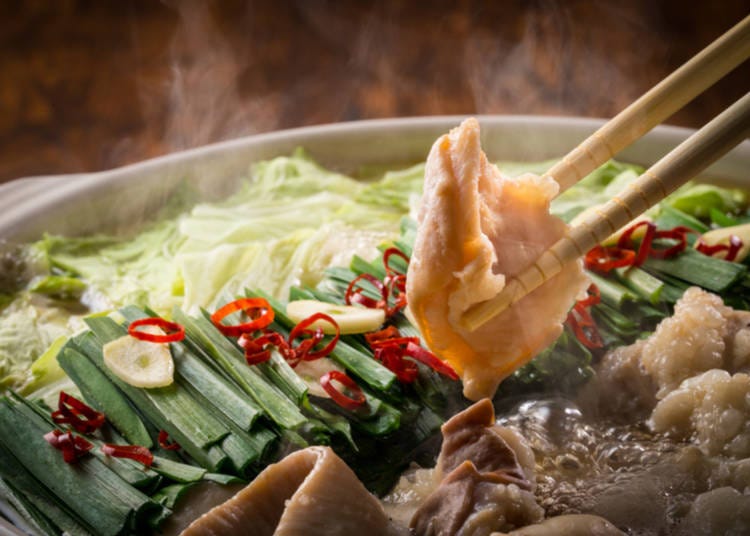
After a good morning’s worth of skiing, or a busy afternoon of skiing, part of what makes skiing so fun is relaxing with good food and drink afterward. And oh boy, does Japan have great food and drink! There is nothing like coming off the slopes for a bowl of ramen or a heaping plate of curry at lunchtime, or taking it easy with a hot cup of sake in the evening.
There is an almost bewildering array of food that you can try every day, and in local restaurants, you are more likely to come across local delicacies which can’t be found anywhere else. Even up high in the mountains, you can try delicious sushi, tuck into a steaming bowl of sukiyaki or get your meat on with some mouth-watering steak.
Your culinary experiences will differ depending on the area of Japan that you visit, with ramen being particularly well known up in the mountains of Hokkaido, and with some resort restaurants offering western-style food and others more Japanese style, and in many cases both. There might just be a food court with food like Japanese curry or Hayashi rice in smaller resorts.
At a Japanese-style restaurant, breakfast is more likely to consist of traditional Japanese food, for example, grilled fish, miso soup, and rice, with vegetables, but at bigger hotels or resorts, you are likely to find a breakfast buffet with both western and Japanese food.
By the end of your trip, you might not remember what your original wish list was for your trip - had you come to Japan to ski or had you come to Japan to eat and drink??
9. Onsen – Japan’s Famous Hot Water Springs which are not to be Missed!
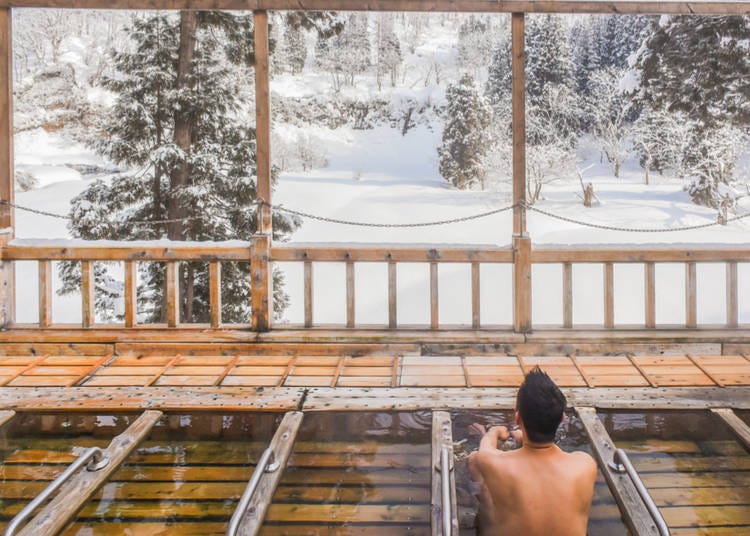
Japan is typically associated with onsen, but vice versa; many tourists do not associate themselves with onsen.
Hot water springs or onsen, where you get naked with other people sounds a bit alien to a lot of people, as well as the nervousness about what to actually do in an onsen (big hint – you can’t just dive into the water!). So it is often regarded as a cultural foible which one talks about but doesn’t actually do.
However, stay with me on this – a soak in an onsen is amazing! You wash thoroughly with the provided soap or shower gel, and then you soak in the water and feel all of your aches and worries literally melt away. In particular, in case you weren’t aware, winter up in the mountains is pretty cold while an onsen will heat up your whole body and will have you more than ready to relax for the evening, or have you set up for a good long sleep.
Japan is a mountainous country, and many of its mountains are volcanoes, with the result that there are many onsens in the mountains! When you go on a skiing holiday in Japan, you are also actually in the best place in the world to enjoy an onsen.
On top of this, many onsens have their hot air baths overlooking amazing winter landscapes; as you sink into the hot water, you can marvel at the beauty of nature.
10. Gorgeous Instragramable Snow Festivals
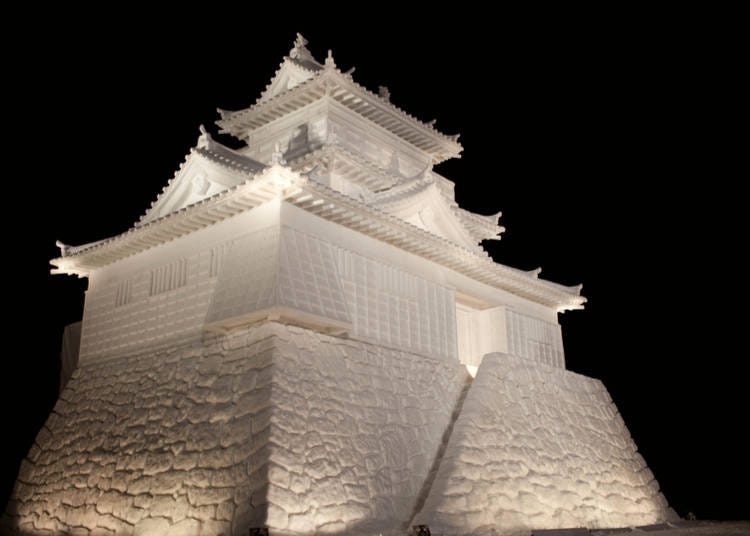
Even in winter's depths, Japanese people love their festivals, and in particular, snow festivals are entertaining and pretty amazing! Sapporo offers you the chance to both ski, slopes are as close as 30 minutes away from the city, but to catch golden moments for your social media accounts with gorgeous ice sculptures!
Sapporo’s snow festival is particularly famous. It is held for one week in February and attracts over two million visitors every year. Ice sculptures are made by local people and organizations, volunteers, local government officials, local self-defense forces, and international teams participating in the International Snow Sculpture Contest.
The sculptures are mainly found in two locations, with a third location in the Tsudome community dome having snow slides and snow rafting.
Alternatively, if you are out skiing near Asahikawa, Hokkaido, which has several ski resorts nearby like Furano ski resort and Kamui Ski Links, has a winter festival in the second week of February. However, the sculptures are actually on display for a month. This festival is well known for its use of giant snow sculptures!
Another popular snow festival can be found in Iwate, in the north part of Honshu, which has taken place for over 50 years. It opens up around mid-February, and in the evenings, they have firework displays too! Across Iwate Prefecture, there are over 153 kilometers of slopes, with the largest resort, Appi Kogen, offering up 45 kilometers of slopes.
- Category
*Prices and options mentioned are subject to change.
*Unless stated otherwise, all prices include tax.
Popular Tours & Activitiess
Recommended places for you
-

Kanzenkoshitsuyakinikutabehodai Gyugyu Paradise Sannomiya
Yakiniku
Kobe, Sannomiya, Kitano
-

ISHIDAYA Hanare
Yakiniku
Kobe, Sannomiya, Kitano
-

Jukuseiniku-to Namamottsuarera Nikubaru Italian Nikutaria Sannomiya
Izakaya
Kobe, Sannomiya, Kitano
-
Appealing

Rukku and Uohei
Izakaya
Sapporo / Chitose
-

Kambei Sannomiyahonten
Yakiniku
Kobe, Sannomiya, Kitano
-
Goods

Yoshida Gennojo-Roho Kyoto Buddhist Altars
Gift Shops
Nijo Castle, Kyoto Imperial Palace
-

Smart Ways to Avoid Crowds and Enjoy a Safe, Comfortable Trip to Myoko, Niigata Prefecture.
-

What to Buy in Aomori? 11 Aomori Souvenirs Locals Actually Recommend
by: ShiroKu inc.
-

Shopping in Akita: 11 Must-Buy Souvenirs & Where to Shop Near the Station and Airport
by: ShiroKu inc.
-
Ad

Why Fukushima is the Next Big Food Destination in Japan The Foodie Paradise Only 90 Minutes from Tokyo
-

Aomori's Quiet Side in Autumn: 5 Scenic Spots in Hachinohe According to a Local
by: Marco Blasco
-
Ad

Just one stop from Haneda Airport! "Truly Japanese!" Food, Fun, and Knowledge Gather at HICityⓇ Enjoy An Electrifying Night at "Japan Night Fever: Haneda Innovation City"
by: Yohei Kato
-

Japanese Foods List: 16 Crazy Tasty Japanese Tohoku Region Dishes You've Never Heard of
by: Guest Contributor
-

Takahan Ryokan: Enjoy Spectacular Hot Spring Views at Yuzawa's Premier Traditional Inn!
-

Enjoy Hokkaido's Winter Magic: 2025 Guide to Snowy Adventures & Skiing
-

When Does It Snow in Kyoto? Winter Weather, What to Wear, and Where to Go in December–February
by: WESTPLAN
-

Local Recommended: 1-Day Itinerary for Enjoying Sapporo's Winter Wonderland (Hokkaido)
by: Nobuka Kawashima
-

13 Popular Festivals & Events in Hokkaido (Fall/Winter 2025-2026)
by: Masakazu Yoshida
- #best sushi japan
- #what to do in odaiba
- #what to bring to japan
- #new years in tokyo
- #best ramen japan
- #what to buy in ameyoko
- #japanese nail trends
- #things to do japan
- #onsen tattoo friendly tokyo
- #daiso
- #best coffee japan
- #best japanese soft drinks
- #best yakiniku japan
- #japanese fashion culture
- #japanese convenience store snacks












